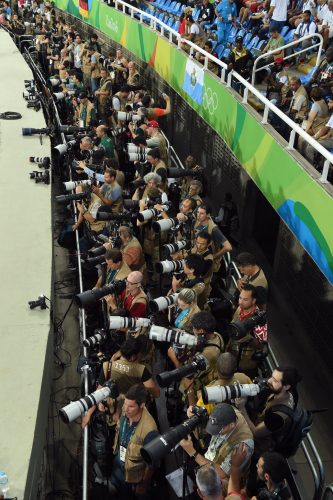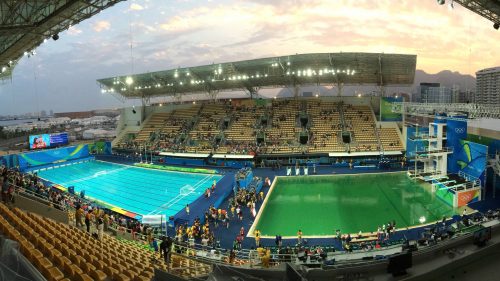VIEW FROM THE OLYMPIC PRESSBOX: Our insider at the Rio Games reports back after the opening week of events, and the fun and games around the Mixed Zones and Media Centre

Any fears that the Rio Olympics would not be a particularly memorable Games have certainly fallen by the wayside.
Some reasons are more obvious than others.
It’s disconcerting to need to have at least one controlled explosion – but four in or around the Olympic venues by the end of the middle weekend is more than a little scary. Especially when one took place in the basketball arena while journalists and staff were still present.
Meanwhile, over at the Maria Lenk Aquatics Centre, a member of the press ops team there said they never wanted to hear the words “green” and “pool” in the same sentence again for as long as they lived.
It’s sure to go down as a Rio 2016 quirk or pub quiz question: “remember the green pool?” But the inability of the organisers to rectify it, as promised, doesn’t fill one with confidence in their capabilities to deal with crises.
Also this week, sports journalists accredited to cover the Games were sent an email warning them not to cross the media bus depot outside the designated areas in case of “hazards”. This failed to mention any caution for stray bullets or rocks that struck a media bus ferrying journalists in the Deodoro zone.
There were no serious injuries, thankfully, save for some minor cuts from broken glass. Depending on who you spoke to the nature of the projectiles changed.
Journalists and even eye-witnesses said they were bullets. Anyone who was in a position of authority in Brazil said they were simply rocks…
The worrying thing for sports reporters, photographers and broadcasters is that a lot of time is spent on these buses. Sometimes much longer than is ideally necessary, with some bus drivers taking U-turns after travelling miles out of their way.
Were it not for the free and gratefully appreciated wifi on all media transport vehicles, the journeys would be quite tiresome.
REAL PROBLEMS continue with thousands of empty seats in the Olympic athletics stadium, even for sessions in which the great Usain Bolt is due to appear. Tuesday’s morning session, including the men’s 200m heats and some decent Brazilian involvement, was reportedly one of the less well-sold sessions. Tickets are too pricy for many ordinary Rio residents, but having a stadium miles away from the other Olympic venues also hasn’t helped.
London 2012 was sold-out for every track session, but Rio 2016 appears to have failed on the ticket-selling front as badly as the 2010 Commonwealth Games in Delhi – another instance of staging a first-world sports festival without considering the citizens of a developing world city – or the 2013 world championships in Moscow.
Lord Coe and the IAAF appear to have achieved nothing in terms of persuading the local organising committee or IOC officials to take some action to fill the empty seats. But Coe did personally intervene after the first session of athletics, when the athletes’ names printed on their bibs were so small and printed so feintly as to be unreadable.
Someone in the IAAF’s marketing department about a decade ago decided that names, rather than bold printed numbers, were more spectator friendly. They clearly never considered the size of type that would need to be used for spectators, trying to identify competitors across a vast stadium, when the bib has to accommodate all the letters in, say, “JOHNSON-THOMPSON”. Numbers were far more practical, and visible, and would also give spectators a reason for buying a programme.
Rio’s choice of type size and font for the athletes’ bibs continued to prove somewhat eccentric. “I wouldn’t be surprised if they used Comic Sans,” one typography pedant in the press tribune grumbled.

MORE NEWS from Neil Wilson, the former Mail reporter and SJA Treasurer, who some believe may have covered every Olympic Games since 1896.
“Small world! A voice in my favourite Copacabana restaurant says, “Hello Neil”, and bless me if it wasn’t the lovely Emily Pidgeon, one of the Mail‘s Seven To Watch kids for 2012, here as a spectator having retired from track. She reminds that of those seven I chose in 2005, Giles Scott wins gold here, Louis Smith a silver and Tom Daley bronze. Didn’t I do well? The oldest when I made choice was Scott at 18, Daley was 12!”
AS WELL AS the bullets/bricks, there has also been the incident of a Turkish reporter from Dogan News Agency recounting how she was attacked in the street by a gang of muggers with volunteers and Olympic staff just metres away.
This was on Friday morning, so in broad daylight, too.
In any city there will be dangerous areas but it just makes journalists even more wary to carefully hide their accreditation so as not to be made a target. It also keeps happening to tourist groups, reportedly, which is remarkable given the amount of security that is visible all around.
- The SJA is the largest member organisation of sports media professionals in the world. Join us: Click here for more details
FORTHCOMING SJA EVENTS
- Thu Dec 15, 2016: SJA British Sports Awards, sponsored by The National Lottery
- Mon Feb 27, 2017: SJA British Sports Journalism Awards, sponsored by BT Sport